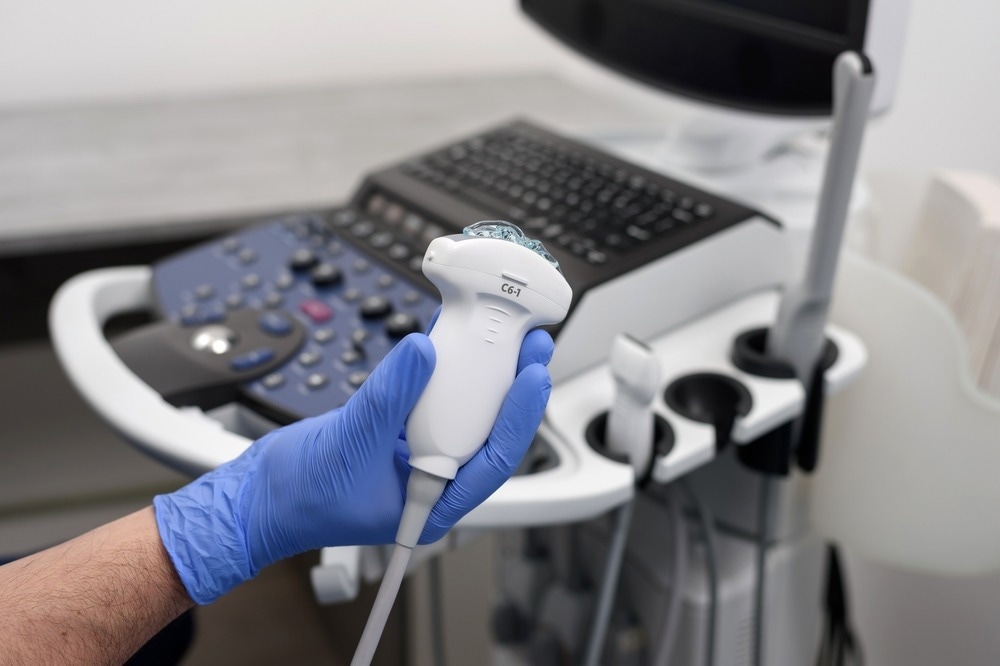 By Taha KhanApr 22 2024Reviewed by Lexie Corner
By Taha KhanApr 22 2024Reviewed by Lexie CornerPiezoelectric materials generate an electrical charge when subjected to mechanical stress.1 This unique property, present in both natural and synthetic piezoelectric materials, has applications in several industrial sectors. This article explores the growing importance of piezoelectric materials in the medical technology sector and their role in innovating and enhancing modern medical devices.

Image Credit: Andrey Zhernovoy/Shutterstock.com
Understanding Piezoelectric Materials
The piezoelectric effect refers to the negative and positive charges that appear on the surface of specific crystals when pressure is applied. This phenomenon was discovered by Pierre and Jacques Curie in 1980 and was named by the German physicist Wilhelm Gottlieb Hankel in 1981.1
Materials exhibiting the piezoelectric effect can be natural, such as quartz, or synthetically made, like lead zirconate titanate (PZT) and polyvinylidene fluoride (PVDF).
Applications in Medical Devices
Piezoelectric materials are used in various medical devices, including ultrasound imaging devices, drug delivery systems, and diagnostic sensors.
In ultrasound imaging, piezoelectric crystals housed within ultrasound probes convert electrical signals into high-frequency sound waves that travel through the body, reflecting off organs and tissues to create detailed images on the screen.2, 3
Piezoelectric medical devices are also used in drug delivery systems, where they convert electrical signals into mechanical motion. This helps regulate medication release at specific rates and durations and ensures optimal treatment effectiveness.
In a recent study, researchers focused on developing piezoelectric micropumps for drug delivery systems, aiming for small, energy-efficient, and reliable devices. They proposed a precise 5 × 5 mm2 silicon micropump capable of delivering bubbles and achieving a maximal water flow rate of 74 ± 6 µL/min.
The pumps exhibited high dosing precision, with a mean standard deviation below 5 % even for extremely small dosages, indicating the potential for miniaturized patch pumps.4
The study emphasized the importance of dosing accuracy, especially for insulin delivery. It highlighted the need for further improvements in pump design to enhance bubble tolerance and dosing precision, particularly with viscous fluids like insulin solutions. This research lays the groundwork for developing highly precise and miniaturized drug delivery systems.4
Piezoelectric sensors are also used in medical devices that can be worn or implanted directly into the body to monitor vital signs and measure pressure changes associated with blood flow. This aids in the early detection of potential health-related problems.5
Advantages of Piezoelectric Materials in Medicine
Piezoelectric medical devices offer many advantages in healthcare. For instance, biocompatible piezoelectric materials provide precision and control in drug delivery systems by modulating drug release rates.4
Similarly, the ability of piezoelectric materials to generate and control the intensity and direction of ultrasound waves is essential for accurate ultrasound imaging. Their ability to detect pressure changes also facilitates noninvasive diagnostic and therapeutic procedures.2, 3
Another significant advantage of piezoelectric materials is their potential for energy harvesting. Piezoelectrics can harness the biomechanical energy generated by body movements to act as a power source for implantable medical devices.
This capability enables the creation of self-powered implants, eliminating external battery requirements or frequent replacements and reducing patient inconvenience and healthcare costs.6
Piezoelectric Power-Driven Device for Non-Surgical Periodontal Treatment
In a 2023 study, researchers examined the efficacy of a non-surgical periodontal treatment utilizing a piezoelectric power-driven device equipped with a newly designed insert.
The study involved 18 patients with varying stages of periodontitis, totaling 437 teeth and 2622 sites. Over six months, significant improvements were observed in clinical parameters, including reductions in probing depth, gains in clinical attachment level, and decreases in gingival inflammation.
The treatment led to a substantial reduction in pathological periodontal pockets and alleviation of chewing discomfort. This approach, utilizing a specially designed piezoelectric tip, demonstrates promising results in enhancing periodontal health.7
Challenges and Innovations
Integrating piezoelectric materials into medical devices poses several technical and biological challenges, including the toxicity of certain materials, as well as invasive implant extraction,
Consequently, biocompatibility, long-term stability, and reliability must be considered when designing and implementing piezoelectric-based healthcare technologies.8
Addressing Implant Stability Challenge via Biocompatible BCZT
In a 2019 study, researchers proposed a novel method to enhance the stability of total joint replacement implants. Traditionally, these implants mimic the biological environment, but instability can lead to prolonged recovery and costly revision surgeries.
This study introduces the use of piezoelectric ceramics as internal electrical stimulation sources at the implant site, aiming to accelerate healing. Unlike wired devices, piezoelectric ceramics can generate electric surface potentials autonomously under mechanical load.
The study focuses on calcium/zirconium-doped barium titanate (BCZT) ceramics, which demonstrate low cytotoxicity and high piezoelectric responses in vitro. These findings suggest that BCZT improves implant ingrowth biocompatibility and stability.9
Future Prospects
The unique ability of piezoelectric materials to convert mechanical energy into electrical signals and vice versa is expected to deliver innovative tools for healthcare diagnosis, treatment, and monitoring.
The potential impact of advanced piezoelectric materials on future medical technologies is transformative. For instance, piezoelectric micropumps are set to revolutionize drug delivery procedures by enhancing precision and accuracy.4 Additionally, piezoelectric wearable health monitors that continuously track vital signs and detect potential health issues in real time can revolutionize the future of healthcare.10
These advancements highlight the pivotal role that piezoelectric technology may play in shaping the future of medical care.
More from AZoM: How Are Hydrogels Shaping the Future of Biomedicine?
References and Further Reading
-
Arnau, A., Soares, D. (2009). Fundamentals of Piezoelectricity. Piezoelectric Transducers and Applications. doi.org/10.1007/978-3-540-77508-9_1
-
Zhou, Q., Lau, S., Wu, D., & Shung, K. K. (2011). Piezoelectric films for high frequency ultrasonic transducers in biomedical applications. Progress in materials science. https://doi.org/10.1016%2Fj.pmatsci.2010.09.001
-
Taghaddos, E., Hejazi, M., Safari, A. (2015). Lead-free piezoelectric materials and ultrasonic transducers for medical imaging. Journal of Advanced Dielectrics. doi.org/10.1142/S2010135X15300029
-
Bußmann, A., Leistner, H., Zhou, D., Wackerle, M., Congar, Y., Richter, M., Hubbuch, J. (2021). Piezoelectric silicon micropump for drug delivery applications. Applied Sciences. doi.org/10.3390/app11178008
-
Chu, Y., et al. (2018). Human pulse diagnosis for medical assessments using a wearable piezoelectret sensing system. Advanced Functional Materials. doi.org/10.1002/adfm.201803413
-
Zheng, Q., Shi, B., Li, Z., Wang, Z. L. (2017). Recent progress on piezoelectric and triboelectric energy harvesters in biomedical systems. Advanced Science. doi.org/10.1002/advs.201700029
-
Rotundo, R., Marini, L., Carere, M., Trezza, C., Marras, G., Nieri, M., Pilloni, A. (2023). A Novel Piezoelectric-Assisted Non-Surgical Periodontal Treatment: A Prospective Case Series. Dentistry Journal. doi.org/10.3390/dj11070178
-
Chorsi, M. T., Curry, E. J., Chorsi, H. T., Das, R., Baroody, J., Purohit, P. K., ... & Nguyen, T. D. (2019). Piezoelectric biomaterials for sensors and actuators. Advanced Materials. https://doi.org/10.1002/adma.201802084
-
Poon, K. K., Wurm, M. C., Evans, D. M., Einarsrud, M. A., Lutz, R., Glaum, J. (2020). Biocompatibility of (Ba, Ca)(Zr, Ti) O3 piezoelectric ceramics for bone replacement materials. Journal of Biomedical Materials Research Part B: Applied Biomaterials. doi.org/10.1002/jbm.b.34477
- Huang, S., Gao, Y., Hu, Y., Shen, F., Jin, Z., Cho, Y. (2023). Recent development of piezoelectric biosensors for physiological signal detection and machine learning assisted cardiovascular disease diagnosis. RSC advances. doi.org/10.1039%2Fd3ra05932d
Disclaimer: The views expressed here are those of the author expressed in their private capacity and do not necessarily represent the views of AZoM.com Limited T/A AZoNetwork the owner and operator of this website. This disclaimer forms part of the Terms and conditions of use of this website.